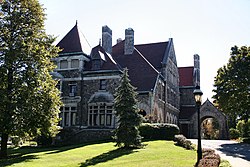Clement Studebaker House | |
 Front of the house | |
| Location | 620 W. Washington Ave., South Bend, Indiana |
|---|---|
| Coordinates | 41°40′30″N86°15′30″W / 41.67500°N 86.25833°W |
| Area | 2.6 acres (1.1 ha) |
| Built | 1889 [1] |
| Architect | Henry Ives Cobb; Christopher Fassnacht & Robert Braunsdorf |
| Architectural style | Romanesque, Richardsonian Romanesque |
| NRHP reference No. | 73000044 [2] |
| Significant dates | |
| Added to NRHP | July 2, 1973 |
| Designated NHL | December 22, 1977 [3] |
Tippecanoe Place is a house on West Washington Street in South Bend, Indiana, United States. Built in 1889, it was the residence of Clement Studebaker, a co-founder of the Studebaker vehicle manufacturing firm. Studebaker lived in the house from 1889 until his 1901 death. [3] The house is one of the few surviving reminders of the Studebaker automotive empire, which was the only major coach manufacturing business to successfully transition to the manufacture of automobiles. In 1973, the Richardsonian Romanesque mansion was listed on the National Register of Historic Places. [2] It was further recognized by being designated a National Historic Landmark in 1977. [3] [4] [5] It is located in South Bend's West Washington Historic District.

